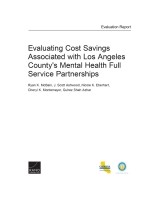| 来源类型 | Research Reports
|
| 规范类型 | 报告
|
| DOI | https://doi.org/10.7249/RR2783
|
| 来源ID | RR-2783-CMHSA
|
| Evaluating Cost Savings Associated with Los Angeles County's Mental Health Full Service Partnerships |
| Ryan K. McBain; J. Scott Ashwood; Nicole K. Eberhart; Cheryl K. Montemayor; Gulrez Shah Azhar
|
| 发表日期 | 2018
|
| 出版年 | 2018
|
| 页码 | 36
|
| 语种 | 英语
|
| 结论 |
Over the five-year period, there were cost savings of $82.9 million associated with the FSP outcomes- Those savings represent a 24 percent reduction in non-FSP government spending.
- For the five outcomes studied, non-FSP government spending on the 24,282 FSP beneficiaries was reduced from $345 million to $262 million.
- The largest cost savings came from reductions in criminal justice detention ($63.1 million in savings). This was followed by savings for behavioral health inpatient stays ($14.2 million, or 18 percent) and homelessness ($2.6 million, or 4 percent).
- When comparing cost savings by group (children, transition-age youth, and adults), the largest cost savings in relative terms came from transition-age youth (30 percent) and in absolute terms from adults ($51.6 million).
- Cost savings were observed across four of the five outcomes examined. The exception was connection to outpatient primary care, where there was a 16 percent increase in spending; however, this increase likely mitigated the risk — and associated costs — of inpatient care for physical health conditions.
The average annual FSP program expenditure for 2012–2016 was $13,807 per client- The total expenditures for the first year of enrollment for the 24,282 enrollees were $335.3 million.
- The estimates of costs and savings are intentionally conservative but indicate that at least 24.7 percent of the expenditures for clients' first year in FSP programs was offset by savings, without accounting for indirect financial benefits, other potential financial benefits not associated with the five outcomes, or any nonfinancial benefits associated with improved health, housing, and employment among beneficiaries.
|
| 摘要 |
- LAC DMH should strengthen its data collection efforts by collecting data on a wider range of outcomes of interest, using multiple-item scales instead of single-item measures, and ensuring that data are collected at regular time intervals. These efforts would improve the value of the data for tracking changes in outcomes over time.
- Improving measurement of client status over time through the key-event records would allow for more-accurate measurements of housing, education, and employment status.
- LAC DMH should measure items that more accurately capture social engagement and meaningful activity.
|
| 主题 | Child Health
; Health Care Program Evaluation
; Health Interventions
; Homeless Populations
; Los Angeles
; Mental Health Treatment
|
| URL | https://www.rand.org/pubs/research_reports/RR2783.html
|
| 来源智库 | RAND Corporation (United States)
|
| 引用统计 |
|
| 资源类型 | 智库出版物
|
| 条目标识符 | http://119.78.100.153/handle/2XGU8XDN/108960
|
推荐引用方式
GB/T 7714 |
Ryan K. McBain,J. Scott Ashwood,Nicole K. Eberhart,et al. Evaluating Cost Savings Associated with Los Angeles County's Mental Health Full Service Partnerships. 2018.
|
|
文件名:
|
x1552496948925.jpg
|
|
格式:
|
JPEG
|

|
文件名:
|
RAND_RR2783.pdf
|
|
格式:
|
Adobe PDF
|
除非特别说明,本系统中所有内容都受版权保护,并保留所有权利。